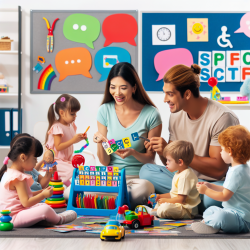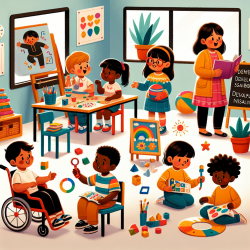Communication is the essence of human interaction, and for children with special needs, it's a critical skill that can significantly impact their academic success and social integration. Drawing insights from the research article "Facilitating Communication in Young Children with Handicapping Conditions: A Guide for Special Educators," this blog aims to provide special educators, speech therapists, and parents with strategies to enhance communication skills in children with special needs. By implementing the outcomes of this research and encouraging further exploration, practitioners can improve their skills and offer more effective support to these children.
The article highlights the importance of selecting optimal phonological target words for highly unintelligible children, a strategy that can be particularly beneficial for special educators and speech therapists. The use of specifically designed pictures and word lists can create facilitative phonetic environments, targeting phonological processes appropriate for children struggling with intelligibility. This approach not only aids in the selection of phonological targets but also in the creation of engaging and effective therapy materials.
Strategies for Enhancing Communication Skills
Based on the insights from the article, here are some strategies that can be employed to improve communication skills in children with special needs:
- Utilize Targeted Phonological Patterns: Implementing the primary target patterns identified in the research, such as syllables, final consonants, and /s/ clusters, can significantly improve the speech intelligibility of children. These patterns provide a structured approach to speech therapy, focusing on the most impactful areas of speech development.
- Incorporate Visual Aids: The use of simple line drawings, as mentioned in the article, can be highly effective in engaging children and facilitating speech production. These visual aids can be used to illustrate target words, making therapy sessions more interactive and enjoyable for young learners.
- Engage in Production Practice Activities: Production practice activities are essential for reinforcing newly acquired speech patterns. The article suggests using pictures for practice, which can be a fun and effective way for children to practice speech sounds and patterns outside of therapy sessions.
- Create a Phonologically Rich Environment: Surrounding children with a variety of phonological targets, beyond those identified as primary patterns, can enrich their phonological awareness and speech development. This can be achieved through reading, storytelling, and engaging in conversations that introduce new sounds and word structures.
- Customize Therapy Sessions: Each child has unique needs and responds differently to various strategies. It's important to customize therapy sessions based on the child's interests, strengths, and areas of difficulty. This personalized approach can maximize engagement and effectiveness.
Encouraging Further Research and Development
While the strategies outlined provide a solid foundation for enhancing communication skills in children with special needs, it's important for practitioners to continue researching and developing their skills. The field of speech therapy and special education is constantly evolving, with new techniques and technologies emerging that can offer improved outcomes for children.
Practitioners should seek out professional development opportunities, such as conferences, workshops, and webinars, to stay updated on the latest research and best practices. Networking with peers and sharing experiences can also provide valuable insights and ideas for enhancing therapy sessions.
Conclusion
Improving communication skills in children with special needs is a collaborative effort that requires dedication, creativity, and a willingness to explore new strategies. By implementing the insights from the research article "Facilitating Communication in Young Children with Handicapping Conditions: A Guide for Special Educators" and engaging in continuous professional development, practitioners can make a significant impact on the lives of these children.
Effective communication is key to unlocking the full potential of children with special needs, enabling them to express themselves, engage with others, and navigate the world around them with confidence. Let's commit to providing the best support possible to facilitate their growth and development.
To read the original research paper, please follow this Facilitating Communication in Young Children with Handicapping Conditions: A Guide for Special Educators.










